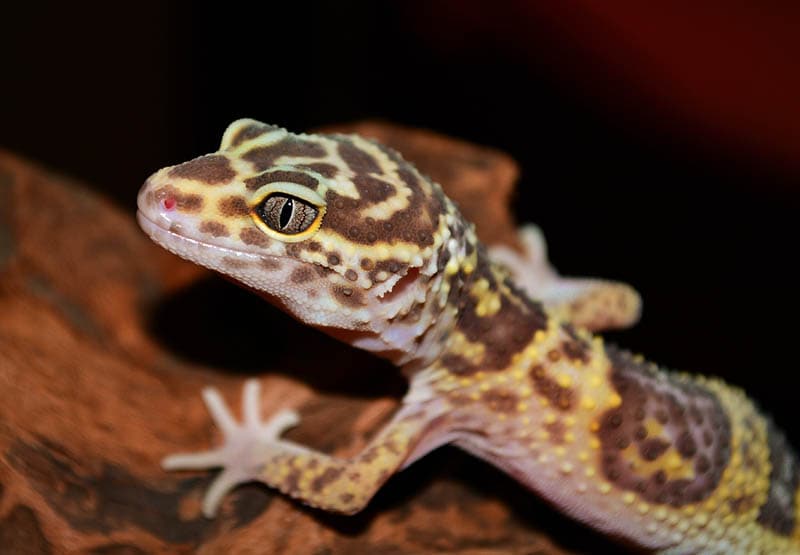The Leopard Gecko is hardy and easy to care for, making it one of the best starter lizards!
The Leopard Gecko Eublepharis macularius is an excellent beginner lizard and great for experienced lizard keepers too. It is a very easy lizard to take care of. It isn’t demanding and it doesn’t require much more than feeding and simple maintenance once its habitat is setup.
This gecko is a desert creature and nocturnal, so it likes to be warm and it tends to get active at night. It is an amazing lizard to observe and feeding time is always exciting. it’s fascinating to watch them hunt and with its amiable nature,it is also fun to hold.
Leopard Geckos are very good with children, though the time spent with them should be supervised. It is very rare that any specimen will bite, and they can be quickly trained out of the behavior. They can hang on your shirt as you walk around and will often perch on your shoulder without the slightest care. They can stress if handled improperly though, so make sure you never grab your Leopard Gecko (or most lizards) by their tail as they can separate it from their body.
These geckos are very hardy and will readily breed in captivity. There are many fascinating specimens available as pets. There is the normal color pattern (as seen in the picture above) with a light base color covered with spots, as well as many color morph varieties. Leopard Gecko morphs can be found with spots or without spots and in many colors including albinos, blizzards, tangerines, those with carrot tails or other alternate tail colors, and lots more.
- For more information on keeping pet lizards see: Reptile Care: Keeping Reptiles and Amphibians as Pets
Scientific Classification
| Kingdom: | Animalia |
| Phylum: | Chordata |
| Class: | Reptilia |
| Order: | Squamata |
| Family: | Gekkonidae |
| Genus: | Eublepharis |
| Species: | macularius |
Scientific Name
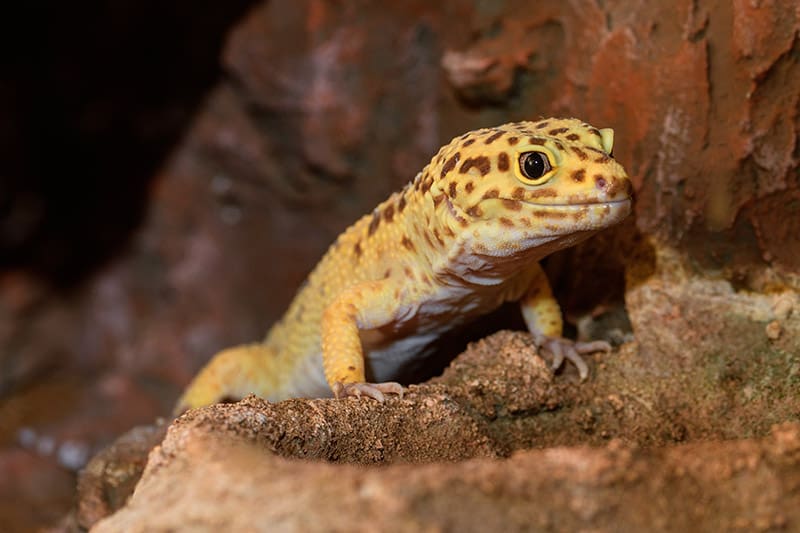
Habitat: Distribution/Background
The Leopard Gecko Eublepharis macularius was described by Blyth in 1854. This is an insectivorous lizard coming from Pakistan, Iran, and Afghanistan. They were imported into North America until the 1970s, when importation became illegal. They live in the desert and are nocturnal.
Status
The Eublepharis macularius is not on the IUCN Red List for Endangered Species.
Description
Leopard Geckos can have a lot of spots, or no spots at all, depending on what variation you have purchased. There are many color variations in the Leopard Gecko, the normal pattern (seen in the picture above), albinos, blizzards, carrot tails, and tangerines are a few of the more popular varieties. Extremely young leopard geckos do not yet have their spots, but will gain them upon maturity.
Leopard Geckos get to be around eight inches long and five to eight ounces. Regardless of their color, they all require the same care. The average life span of these lizards is five to seven years, but with good care they can live to be around 20 years old.
There is little visible difference between the sexes. The easiest way to tell them apart is to look at the hemipenes; the bulges at the base of the tail. The female Leopard Gecko will have one long bulge, but the male’s hemipenes will be divided into two.
Food and Feeding
Leopard Geckos eat crickets and mealworms. You can offer an occasional wax worm too, but you should limit these as they have a high fat content (20%). It is highly recommended that you ‘gut load’ your crickets with any of the commercially available gut loads. These vitamin-rich foods fill the crickets with the vitamins and minerals, so that when your lizard eats them, the lizard gets all of the good stuff too. The meal worms should be provided in a dish with some sort of calcium to get the calcium in their diet.
As a nocturnal species, Leopard Geckos often have a vitamin deficiency in the area of vitamin D3. To compensate, you could either add a fluorescent bulb with UV to your set up, or you could use a calcium powder with the vitamin already included. The lizard must have vitamin D3, or it cannot make use of the calcium.
Provide a water bowl, preferably with dechlorinated (distilled) water. If you choose to use a dechlorinator, Repti Safe is a good one to use as it also provides electrolytes.
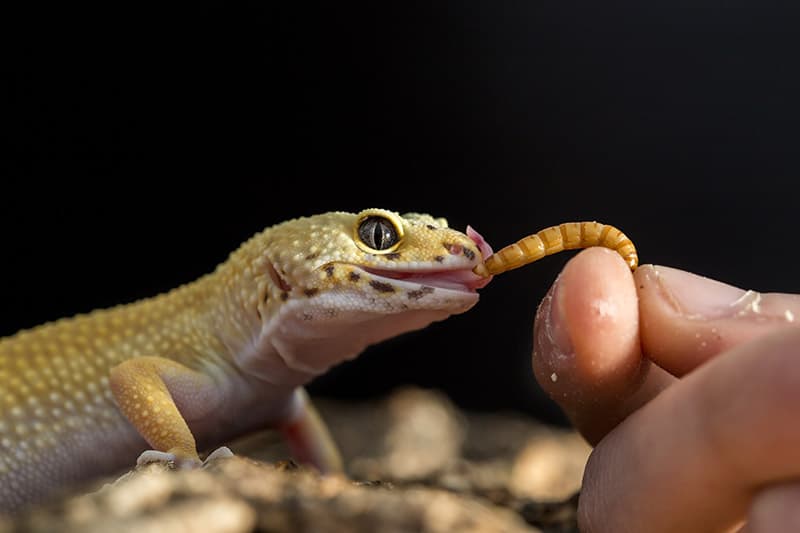
Housing
A single Leopard Gecko can make its home in a ten gallon fish aquarium with a screen top, while two or more can fit in a twenty gallon long/breeder. Do not use an acrylic tank of any sort for lizards as the heat lamps will often melt the acrylic. The Leopard Gecko should have one hide per gecko. They will sleep in these during the day. They will also enjoy something to climb on, such as a piece of grapevine, available at many pet stores.
Be cautious with substrates such as calci-sands. If the sand is the only source (or the nearest) of calcium, the reptile could consume large amounts and the sand can impact the intestinal tract. This can create a blockage and ultimately killing the lizard. Carpet, paper towels, or a walnut-shell bedding (Nature Zone Litter) are preferable, as the walnut-shell does not swell with the liquid.
These lizards should never be kept outside. The risk of mites is great when kept outdoors, as well as unpredictable temperatures and weather conditions. See the terrarium set-ups described under Basic Reptile and Amphibian Care for more information on housing.
Temperature and Lighting requirements:
Leopard Geckos do well at 84-88 degrees F (29-31 C) in the daytime and 74-78 F (22-25 C) at night. As they are nocturnal, these lizards do not require UV light for calcium absorption as many other lizards do, though it can be a useful addition for this purpose.
For lighting and heat a 40-60 watt bulb placed on a screen top at one end of the terrarium is sufficient. This can be either a white or a red (infra red) bulb, there is also a blue bulb available. The red or blue bulb provide will provide warmth as well as allow you to view your pet at night. Because Leopard Geckos are ectothermic they thermoregulate their body temperature, going from cool areas to warm areas as they need to. By placing the bulb on one end of the enclosure this leaves the other end as a cooler zone.
You can also provide a heating pad or under tank heater under the aquarium for additional heat. This is especially important if you use a white light and turn it off at night. A hot rock is not recommended as these lizards can be easily burned by one. Be sure you use a thermometer so you don’t let the terrarium become overheated or under heated.
Cage Care
Cage maintenance is an important part of keeping reptiles healthy, and long-lived. Reptiles being kept in a confined area as pets need to be protected from harmful micro-organisms and parasites. The reptile cage needs daily and weekly maintenance. Check on a daily basis to make sure that the tank is clean.
Everything you put into their home should be washed and disinfected weekly. This includes dishes and cage decor. All of the substrate should be changed every three to four months. Never clean with a phenol such as Pine Sol. Chlorine and alcohol based cleaners are tolerated much better, but need to be thoroughly rinsed.
Leopard Geckos, true to their easy-to-care-for attitude, will generally only defecate in one area of the cage. For cleaning, you can use any reptile-approved cleaner, such as Jurassi Clean. You may also wish to get a sand scoop as it is easiest just to sift this out whenever they relieve themselves. Leopard Geckos will also enjoy misting every once in a while, with dechlorinated water if possible.
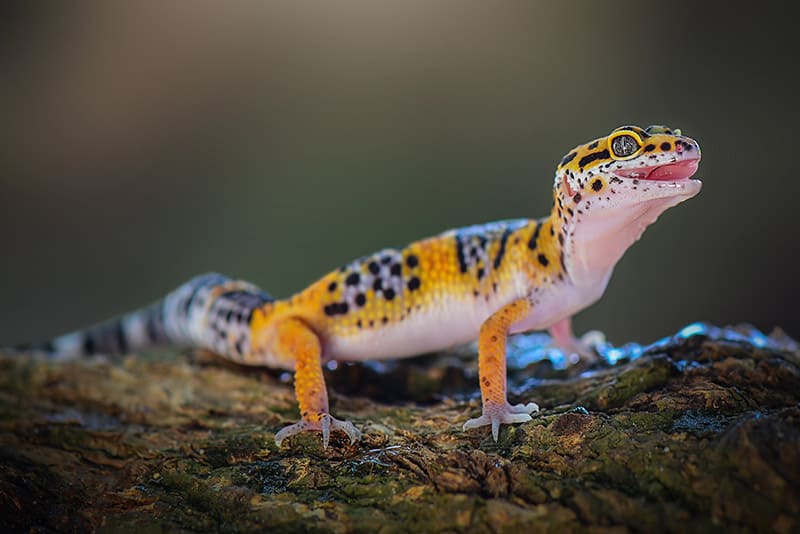
Behavior
These spotted lizards are desert creatures and nocturnal. They are very friendly and good with children. It is very rare that any specimen will bite, and they can be quickly trained out of the behavior. They can be perched on your shoulder or will hang on to your shirt as you walk around.
Leopard Geckos are relatively amicable with females of their own species, but two males housed together will fight to the death. If you have more than one, it should be one male with any number of females, provided you have space for them all. If your Leopard Gecko gets in a situation where it feels threatened and perhaps grabbed by the tail, it will separate its tail from the rest of the body (autotomy). It will regenerate the tail, though it will never grow back to its former beauty.
Handling
The Leopard Gecko can be handled gently and will not tend to bite. Be careful so as not to bruise or hurt it. Never pick it up by the head or tail. A tame gecko can perch comfortably on your shoulder or hang from the front of your shirt. Always wash your hands before and after handling your pet gecko.
When handling your gecko, take care not to take it outside in cold temperatures. While the desert does get cold at night, your critters are generally in a burrow deep underground, where it only ever reaches 56{deg} F.
Reproduction
You can breed one male with as many females as you wish, provided you have the space for them, their babies, and places to sell the babies once they’re ready to go.
Leopard Geckos younger than three to four months are difficult to sex visually. Adults are fairly easy to sex at about nine months of age. Males tend to be a bit more bulky and have a slightly broader head and neck than the female. Also males will develop an external pair of hemipenal bulges just behind the vent at the base of the tail. They will also develop an inverted ‘v’ shaped row of inverted scales in front of the vent. Females do not have the bulges and the ‘v’ shaped row of scales are small.
If you are unsure as to whether your lizard is male or female, when introduced to another lizard, if they wag their tails back and forth very quickly (often seen right before they pounce on a cricket), the chances are that you have two males. Is recommended that you wait until a female weighs at least four ounces before you start her in a breeding program, though the bigger she is, the better.
Reptile mating is a brutal process and you may even think that the male is attacking the female. He will start by nipping at her tail, then will slowly move up her body, until he reaches her neck. He will then mount her.
The female will have one or two eggs at a time. You can ‘temperature sex’ the little lizards by deciding what temperature to incubate them at. For mostly females, incubate at 78{deg} – 83{deg} F. For a mix, incubate at 84{deg} – 87{deg} F, and for mostly males, incubate at 88{deg} – 91 {deg} F. Keep in mind that lizards incubated at higher temperatures are generally more colorful and also hatch faster. Incubation period is between 46 and 60 days. A traditional hovovator will do the trick for an incubator and can be bought at around thirty dollars, so they are not that expensive.
The young lizards will not eat until after their first shed. The lizard needs to eat their shedded skin, as it contains vitamins and nutrients that the lizard needs. After this, they will start eating small or pinhead crickets and small meal worms.
Diseases: Ailments/Treatments
The Leopard Gecko is one of the hardiest geckos in captivity with relatively few problems if kept properly.
Some of most common problems encountered with Leopard Geckos are: vitamin deficiency, coccidia, anorexia, gastroenteritis/diarrhea, autotomy/tail loss, Metabolic Bone Disease (MBD), mouth rot, egg binding, sand impaction, shedding problems, respiratory disease, prolapse, and stress. All of these can be avoided with proper care and nutrition, and a good clean environment.
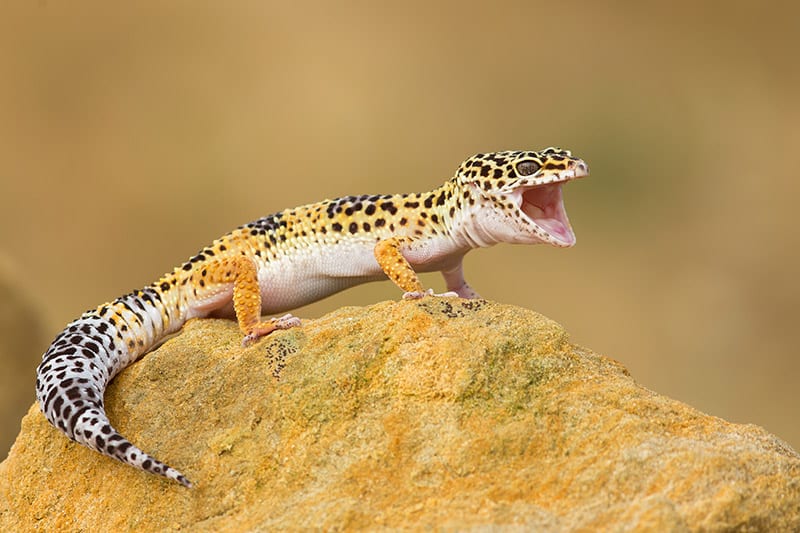
Availability
Leopard Geckos are readily available for sale, and many can be bought at around thirty US dollars at pet stores. More expensive and rarer varieties are often available from breeders via the internet.
Featured Image Credit: JumpStory
